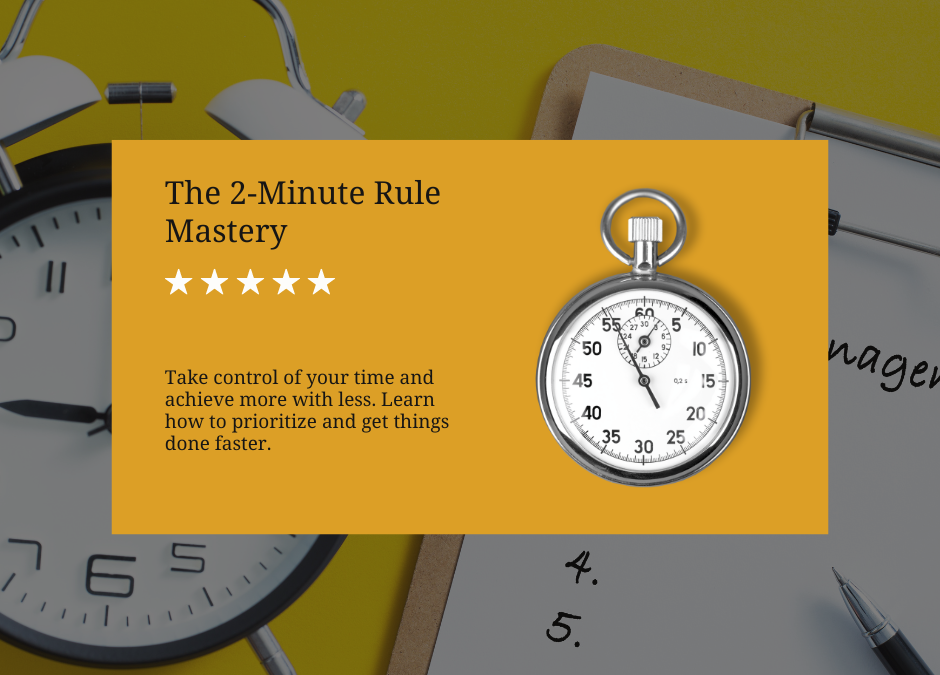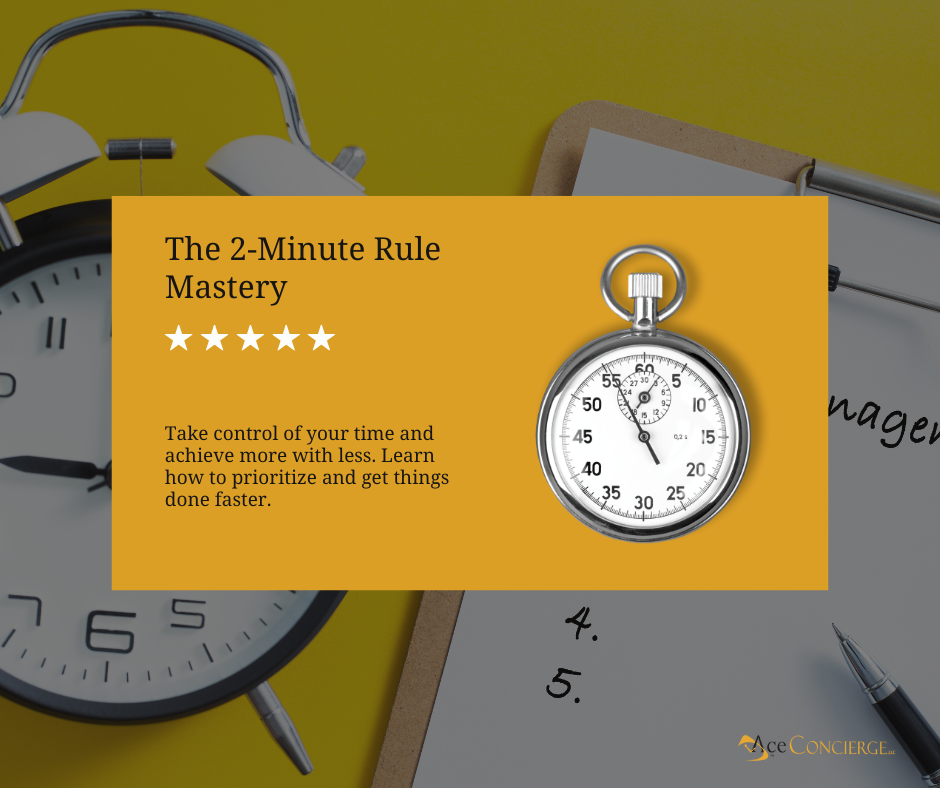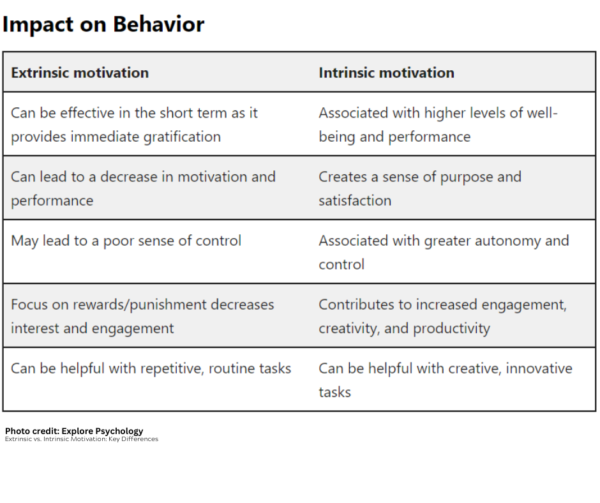
by Ace Concierge | Virtual Assistant | Apr 10, 2024 | Business Transformation, Productivity, Small Business

Hey, productivity masters! Today, I’d like to discuss a practical tool that significantly impacted my daily routine—the 2-Minute Rule. If you’ve ever felt overwhelmed by an ever-growing to-do list, this approach might be the solution you’re looking for.
It is quick, effective, and efficient. Let’s go!!
The Struggle of Overwhelming To-Do Lists
We’ve all been there. You sit down at your desk, determined to conquer the day, armed with a list of tasks that seems to grow exponentially as the hours tick by. It’s like playing a never-ending game of whack-a-mole, except the moles are your responsibilities, and they keep coming back. It’s just not doable.
I believed in prioritizing big tasks for maximum productivity. However, complex, high-level tasks require scheduled ‘deep focus.’ Allocate dedicated time for those larger projects and employ the 2-Minute Rule for the rest.
Enter the 2-Minute Rule
Cue the entrance of the 2-Minute Rule, my knight in shining armor, in the battle against an unruly to-do list. The concept is simple yet profound – if a task takes less than 2 minutes, do it immediately. No delays, no procrastination. Set a timer if you must, but get it done.
This strategy works wonders because, let’s face it, the small tasks are like weeds. Ignore them for too long, and suddenly your garden is overrun. Addressing tasks that take less than 2 minutes immediately prevents the accumulation of tiny chores that collectively can be a time-consuming nightmare.
Identifying the 2-Minute Tasks
You might wonder how to spot these quick 2-minute tasks. It’s simpler than you think. Consider them the readily manageable items in your productivity list—the emails needing a swift response, the postponed phone calls, or the documents needing minor edits.
If a task requires minimal effort and can be completed quickly, it falls into the 2-minute category. Remember that we’re not discussing monumental challenges; instead, we’re focusing on those doable tasks that, when addressed collectively, significantly enhance your daily efficiency.
Setting the Timer and Taking Control
One of the beauties of the 2-Minute Rule is its simplicity. All you need is a timer – your phone, a kitchen timer, or even an old-school hourglass. When you come across a task that fits the criteria, set the timer for 2 minutes and dive in. You’ll be amazed at how much you can accomplish in such a short time.
The timer serves as your accountability partner, urging you to stay focused and avoid getting lost in the black hole of small tasks. It transforms the mundane into a challenge, and who doesn’t love a good challenge, especially when it leads to increased productivity?
Breaking the Procrastination Cycle
Let’s be real; we’re all guilty of procrastination. There’s something strangely satisfying about pushing tasks to the bottom of the pile, convincing ourselves we’ll get to them eventually. But here’s the kicker – eventually rarely comes.
The 2-Minute Rule is a procrastination buster. It breaks the cycle by making tasks so manageable that delaying them becomes absurd. It’s like telling yourself, “Why put it off for later? What can I finish now and be done with it?”
My Transformation
I can’t stress enough how this simple rule transformed my daily life. The feeling of accomplishment that comes from quickly knocking off tasks is addictive. Instead of feeling overwhelmed by the never-ending to-do list, I now see it as a series of small victories waiting to be claimed.
The big tasks still loom on the horizon, but they no longer cast a shadow over my entire day. By mastering the 2-Minute Rule, I’ve regained control of my time. I no longer dread the small tasks, and my productivity graph has shot through the roof.
So, there you have it – the secret weapon that helped me regain control of my time and boost my overall productivity. The 2-Minute Rule is not just a strategy; it’s a mindset shift. It’s about acknowledging the power of small actions and understanding that they add to significant results.
Try it; set a timer, tackle those quick tasks, and witness the magic unfold. The 2-Minute Rule is not just a time management technique; it’s a game-changer that puts you back in the driver’s seat of your day.
Say goodbye to the overwhelm and hello to ultimate time control! ⏰

by Ace Concierge | Virtual Assistant | Feb 14, 2024 | Leadership, Life Thoughts, Productivity
We all dream of a better life, but sometimes we forget that the smallest steps can lead us to greatness. Welcome to the world of micro-habits! These little guys are the secret to unlocking a world of efficiency and happiness.
Unleashing the Power of Micro-Habits
Micro-habits are the tiniest of tiny habits. They are like mini superheroes that, when used consistently, can change your life. Unlike big, scary habits, micro-habits are simple and easy to sneak into your daily routine.
The Science Behind Micro-Habits
Our brains love rewards, and micro-habits deliver! When we do something positive and tiny, our brain gets a boost of happiness, making us want to do it again and again.
Starting with One Tiny Habit
Time to start your micro-adventure! Pick one area in your life that needs a little help and find a tiny habit that can help. Maybe it’s doing a quick stretch, drinking more water, or taking a deep breath. Remember, the little things can add up to big changes.
Consistency is Key
The magic of micro-habits is that they need to be done regularly. Set a time for your chosen micro-habit and stick to it. The more you do it, the more it becomes a part of your routine.
Stackable Habits for Maximum Impact
Micro-habits are like building blocks – you can stack them for a bigger impact. Find an existing habit you already do and add a new micro-habit to it. Maybe it’s doing a little dance while brushing your teeth, or taking a deep breath before checking your email. James Clear talks a great deal about habit stacking in Atomic Habits. (also available on Audible!!)
Doing a little bit is infinitely bigger and better than doing nothing. Stephen Guise, Mini Habits: Smaller Habits, Bigger Results
10 Micro-Habits to Start Today:
- Morning Stretch Ritual: Wake up and shake up! Stretching for just a few minutes each morning will loosen up your muscles, enhance flexibility, and energize you for the day ahead.
- Hydration Reminder: Water is life! Keep your hydration in check by setting a reminder to drink a glass of water every hour. It’s a simple yet powerful habit that can contribute to your overall health and vitality.
- One-Minute Mindfulness Breaks: Take a break from the hustle and bustle of your day by practicing mindfulness. Spend just one minute focusing on your breath to center yourself and promote mental clarity.
- Daily Gratitude Journal: Take a few minutes each evening to jot down three things you’re grateful for. This simple act of gratitude can shift your perspective and promote a more positive outlook.
- Tech-Free Time Before Bed: Give your mind and body time to unwind by putting away electronic devices at least 30 minutes before bed. This promotes better sleep quality, and who doesn’t love a good night’s rest?
- Single-Tasking Practice: Ditch the multitasking and focus on one task at a time. Break your day into smaller chunks and fully immerse yourself in each activity to boost concentration and productivity.
- Lunchtime Walk Routine: Take a break from your desk and get moving! A brisk walk around the block during your lunch break can boost energy levels and contribute to overall fitness.
- Five-Minute Desk Declutter: Clear your mind by clearing your workspace. Spent just five minutes tidying up your area before wrapping up your workday to promote mental clarity and focus.
- Expressive Breathing Exercise: Take a few minutes to practice diaphragmatic breathing. This simple breathing exercise can calm your nervous system and reduce stress, leaving you feeling refreshed and ready to tackle the day.
- Evening Reflection Time: Before bed, take a moment to reflect on your day. Consider what went well and what you learned. This micro-habit encourages self-awareness and continuous improvement.
Embracing the Micro-Revolution
Listen up, folks! Here’s the trick to mastering micro-habits: start tiny and stay the course. Pick a few from our list above, stick ’em in your daily routine, and watch them grow. Before you know it, these small steps will lead to a giant leap towards a happier, more productive life.

by Ace Concierge | Virtual Assistant | Jan 17, 2024 | Leadership, Productivity

Behold the secret sauce of thriving organizations: employees who are more than just content – they’re happy, productive, and unstoppable!
What’s their source of superpowers? Motivation. But what’s the secret formula: intrinsic or extrinsic?
We’re about to get to the bottom of it and dish out some tactical tips to inspire your team.

Intrinsic Motivation:
Imagine motivation that comes from within, a personal drive fueled by passion and pure delight. External factors do not sway this kind of motivation – it’s sustainable, resulting in job satisfaction, engagement, and commitment. The sweet reward? Productivity skyrockets and creativity flows like a river. To nurture intrinsic motivation, try these tricks:
Create Growth Opportunities:
Offer opportunities for personal and professional development. When employees feel they’re learning and growing, motivation follows. Training, mentoring, and career development programs can be powerful drivers for growth.
Empower Autonomy:
Let your team take ownership of their work and make decisions independently. Autonomy breeds responsibility and engagement. Encourage your team to take initiative and make decisions with confidence.
Assign Meaningful Work:
Connect tasks to a sense of purpose and meaning. Ensure your team knows how their work contributes to the company’s overarching goals.
Extrinsic Motivation:
On the flip side, there’s external motivation driven by rewards, recognition, and the fear of consequences. Tangible rewards like money and acknowledgment can be incredibly effective. But be warned, there are potential drawbacks like short-term focus and diminishing motivation over time. To cultivate extrinsic motivation, consider these tactics:
Rewards and Recognition:
Promotions, bonuses, and other incentives can fuel effort and goal attainment. Recognition programs are equally effective in lifting morale and motivating employees.
Establish Clear Expectations:
Make sure your team understands what’s required for rewards or to avoid unfavorable outcomes. Ensure your expectations and guidelines are clear and concise.
Offer Constructive Feedback:
Regular feedback helps employees gauge their performance and areas for improvement. Ensure your feedback is specific, encouraging growth, and timely.

So, which is better? The ultimate recipe for success is a balance of intrinsic and extrinsic motivation. Each approach has its unique benefits, and it’s up to you to determine which works best for your team.
Remember, a happy workforce is the heartbeat of a successful organization. Whether it’s inner fire or external rewards, it’s vital to cultivate and sustain a motivational culture that fuels productivity and passion.
A well-motivated team is a winning team!

by Ace Concierge | Virtual Assistant | Feb 15, 2023 | Business Transformation, Executive Assistant, Productivity, Technology, Virtual Assistant

by Ace Concierge | Virtual Assistant | Jan 18, 2022 | Productivity, Technology

Your technology needs to optimize your efficiency, otherwise, you become buried in useless tools that only suck up your valuable time, and bottom-line, making you less efficient and productive.
If you’re like most business owners, you employ a variety of devices, utilize various online platforms, and have downloaded a host of apps and programs to help you conduct your daily life and business.
We all love the shiny objects and opportunities to test new tools or play with something we ‘think’ is more fun or better than what we currently have. The grass is always greener, right?
Well, it isn’t. Not ALL of the time.
“Shiny Object Syndrome” and is relatively commonplace amongst business owners who don’t have streamlined business processes to handle everyday operations and organize new ideas. Jennifer Goldman, Business Transformer, CFP
Your fancy tech and tools could be bogging you down. Whether you’re tied to managing the tools, remembering logins (there’s an app for that), creating profiles, figuring your goals and desires for data mining and outcomes, collecting data, sorting data, applying data, thinking about the data, you could be effectively drowning yourself in a sea of wastefulness. As a result, you’re creating more busywork and To Dos to get done.
STOP! Take a minute to consider every tool or platform you use on a daily or monthly basis. List them on paper (or your computer). Did you remember EVERY single one?
According to chiefmartec.com, in 2020, there were over 8,000 tech platforms! Click HERE to see their graphic and blow your mind.
In this 2016 VentureBeat article, their graphic depicts an extensive myriad of platforms to manage inside sales. Here we are in 2022, you can bet that the number of programs has multiplied exponentially.
Let’s dial it back to you and your set of tools and software programs.
Questions about your tech stack:
- Do the tools add to or take away from your collaboration?
- Do your tools add REAL value to your operations and desired outcomes?
- Do your apps offer full integration with each other?
- What would you lose if one of them shut down?
- Is there any redundancy in capabilities or features?
- Are these apps ALL on a do-or-die basis?
- Are there tools you can do without?
- Does the costing fit within or exceed your budget?
- Are you gaining a competitive edge or just using the latest tool?
What will you do with the results of your Tech Stack probe? It is up to you to vet each tool for value-add and benefits across your organization. The investment you make should meet your goals while supporting your team, collaborative partners and corporate mission.
If your tools fall short, or your tech stack looks more like a tornado of shiny objects, create a spreadsheet or chart of choice, to clearly outline the features, benefits, and costs. There’s nothing worse than worthless clutter.
What’s your plan to optimize your tech stack?

by Ace Concierge | Virtual Assistant | Nov 19, 2021 | Organization, Productivity, Time Management

If you work from home, your office desk may be hindering your productivity. Have you ever entered your office to find it in disarray? Or maybe you have spilled coffee or tea all over your desk?
That’s a case of having to get your home office desk organized urgently so you can get your work done.
But why wait until you spill coffee or soda all over your work?
Your Organized Home Office Desk Helps Increase Your Productivity
How you wonder? According to Forbes, the typical executive today wastes almost one month a year searching for lost information.
Imagine a whole month looking for something that if you were organized you would have saved that much time?
What would you do with a months’ time? You could actually take a vacation! Or work more and make more money and still take a 2-week vacation. Imagine that?
How to Get Your Home Office Desk Organized
- Take everything off your desk and dust it. Make it shine.
- Next only put your laptop on the desk.
- Then add items like a pen and pad near your dominant hand. If you have several pens/pencils, put them in a container and leave just one on the desk. This helps you focus more on one thing and not multi-task.
- Only keep what you need on your desk. Anything that you reach out for often or have to leave your desk for.
- Keep some open space, it helps your mind wander and be more creative. Creativity for running a business is important as you need to make changes and pivot for your success.
- Do not keep a pile of paper on your desk. Only the important few pieces.
- Next, make sure your laptop desktop itself is not cluttered.
- Keep a to-do list and schedule nearby on your office desk.
- Hang some inspirational quotes or photos on the wall of your home office.
Why Declutter?
By decluttering your office desk space, you feel better. When you feel better, you can work better and be more productive and creative.
Also start decluttering the other spaces around your home office desk. For example, drawers and shelves. Keep them simple and clean.
Next time when you enter into your office home space you will feel refreshed and ready to begin working. You won’t be thinking about all the stuff you have to clean as you work from home.
Organize the Rest of the Office
Now that you have your office desk organized, you can move on to the other areas of your room. Whether it be in the drawers or other pieces of furniture keep things to a minimum.
You may be surprised to see how much stuff you kept, that you didn’t really need. Maybe you can move some of your unneeded documents to a zip drive.
Anything to save on paper and clutter on the actual office desk and make you more productive.
Make it Your Own Space
Style your home office to your own flavor. Many may love the man-cave look for their offices and others want a more feminine touch. Whatever style makes you happy and feel good, is the style you will want to go with. Use your favorite colors for the paint, rugs, or furnishings in your home office.
Of course, feeling comfortable in your own home office will help you be more productive each and every day.
If you work off your dining room table, you may be easily distracted. You may also spend more time looking for things you need to get the tasks at hand done.
Working from a Clean Home Office Space
Now that your office is all cleaned up you will feel ready to tackle anything that comes your way. You will be able to find things quicker and get more done.
You may even be inclined to do other areas of your home to make the rest of your life more pleasant and stress-free. Having clutter can be a stressor for many people.
The less clutter you have, the fewer decisions you have to make, the less you have to look for stuff, and the less overall stressed you will feel.
You will be able to live more productively, happy, and be more successful in your business.
Guest Author Lisa Sicard
 Lisa loves helping others to thrive online through Social Media, Blogging, and SEO. What good is knowledge if you cannot share it with others? She has 30+ years of experience in marketing/advertising with 9 years of experience in content marketing, social media, blogging, and SEO. Check out her latest eBook “How to Tweet and Thrive on Twitter” now on Amazon.
Lisa loves helping others to thrive online through Social Media, Blogging, and SEO. What good is knowledge if you cannot share it with others? She has 30+ years of experience in marketing/advertising with 9 years of experience in content marketing, social media, blogging, and SEO. Check out her latest eBook “How to Tweet and Thrive on Twitter” now on Amazon.














